The Spasticity Treatment Market is estimated to be valued at USD 15.3 billion in 2025 and is projected to reach USD 33.4 billion by 2035, registering a compound annual growth rate (CAGR) of 8.1% over the forecast period.
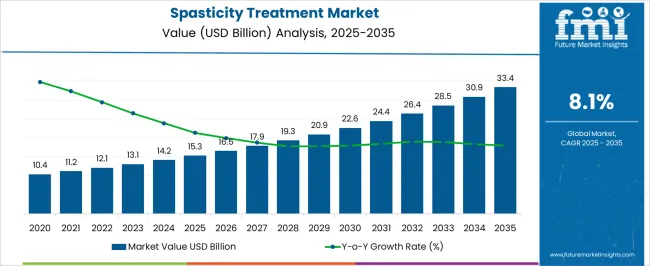
| Metric | Value |
|---|---|
| Spasticity Treatment Market Estimated Value in (2025 E) | USD 15.3 billion |
| Spasticity Treatment Market Forecast Value in (2035 F) | USD 33.4 billion |
| Forecast CAGR (2025 to 2035) | 8.1% |
The spasticity treatment market is expanding steadily due to increasing cases of neurological disorders, advancements in diagnostic imaging, and rising demand for targeted therapies. Greater awareness among patients and healthcare providers about early intervention has been a significant factor driving adoption across both developed and emerging economies.
Continuous innovation in pharmacological and non pharmacological interventions, coupled with regulatory approvals for novel treatment modalities, is enhancing market accessibility. Growing investments in rehabilitation programs and supportive government initiatives are further reinforcing market growth.
The outlook remains positive as healthcare systems emphasize integrated care models, combining precise diagnostics with advanced therapeutic approaches to improve patient quality of life and reduce long term healthcare burdens.
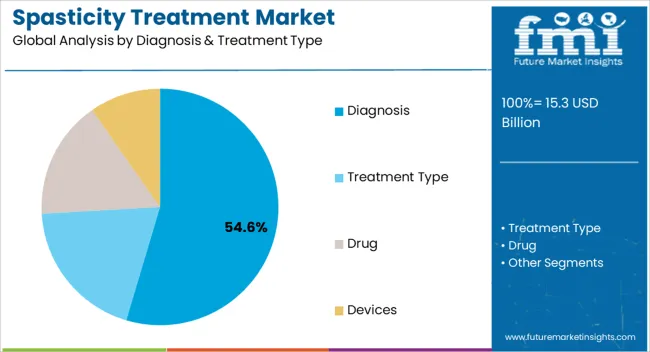
The diagnosis segment is projected to account for 54.60% of market revenue by 2025, positioning it as the leading category under diagnosis and treatment type. This dominance is attributed to the rising importance of early and accurate detection of spasticity to initiate timely treatment interventions.
Increased adoption of imaging technologies and clinical evaluation tools has enabled healthcare professionals to assess severity levels and tailor treatment pathways more effectively.
The integration of advanced diagnostic methods within hospital and specialty care settings has further reinforced this segment’s leadership, ensuring that early diagnosis translates into improved therapeutic outcomes.
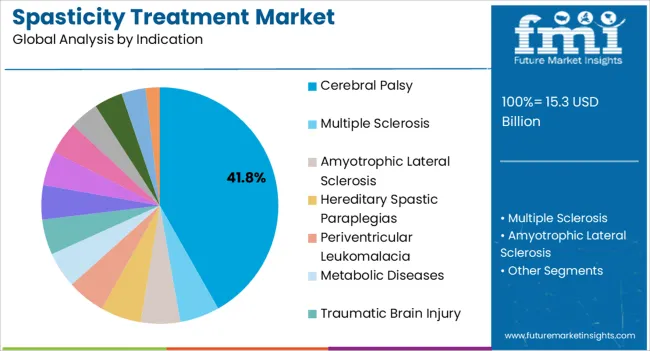
The cerebral palsy indication segment is expected to hold 41.80% of total market revenue by 2025, making it the most prominent indication area. This growth is being driven by the high prevalence of cerebral palsy among pediatric patients and the long term management needs associated with the condition.
Ongoing advancements in treatment modalities, including botulinum toxin injections, physiotherapy, and orthopedic interventions, are addressing patient specific requirements more effectively. Awareness campaigns and supportive healthcare policies are also contributing to improved diagnosis and sustained treatment adoption.
The chronic and lifelong nature of cerebral palsy continues to ensure that this indication maintains its dominant position in the spasticity treatment landscape.
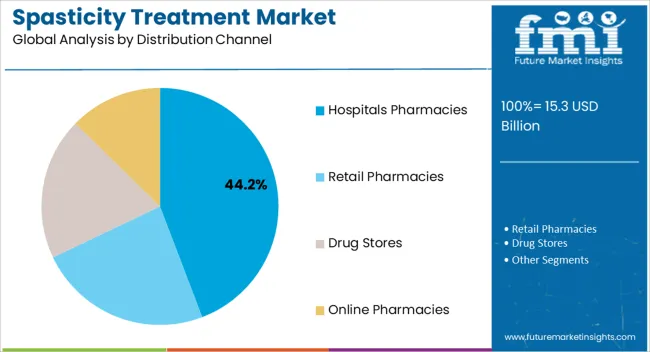
The hospitals pharmacies distribution channel segment is set to capture 44.20% of overall market revenue by 2025, emerging as the leading distribution avenue. This dominance is supported by the extensive availability of advanced therapeutic options, structured patient management programs, and multidisciplinary care offered in hospital settings.
Hospitals pharmacies play a pivotal role in ensuring timely access to both diagnostic tools and prescribed medications, enhancing treatment compliance. The integration of spasticity management within hospital based rehabilitation programs has further strengthened this channel.
With patients increasingly seeking comprehensive treatment under one roof, hospitals pharmacies are positioned as the preferred choice for spasticity care delivery.
Sales of the global market grew at a CAGR of 5.4% between 2014.22 and 2025. Spasticity treatment market contributes 29.6% revenue share to the global neurodegenerative disease treatment market value at USD 14.25.3 Billion in 2025.
The ageing population is one of the primary factors fueling the market for spasticity treatments.
Age-related changes in the brain, traumas like stroke or traumatic brain damage, addiction, and diseases like multiple sclerosis (MS), stroke, and brain tumours, among others, can all have a substantial impact on brain health, which will increase the prevalence of spasticity and its related indications, which will boost the market for spasticity treatments.
Advanced procurement operations provide businesses and manufacturers with chances to develop and expand their clientele to buyers and suppliers that collaborate to create cutting-edge products that increase sales and profits for all parties. By implementing several techniques into their processes, they adopt an integrated approach to creating new goods and procedures.
Different key strategies such as new product launches, acquisitions, collaborations, and expansion are being used by companies and different manufacturers for the advancement and development of new products and therapies.
Considering this, FMI expects the global market to grow at a CAGR of 8.14.2% through the forecasted years.
Cognitive knowledge and evaluation of everyday things and issues is one of the most important indicators of a person's mental health and ability to think and act in life-or-death situations.
The brain is a sophisticated organ that has a significant impact on one's overall health and well-being. Brain health can be significantly impacted by ageing-related changes in the brain and traumas like stroke or traumatic brain injury. While certain factors that affect brain health cannot be avoided, there are other lifestyle changes that can be beneficial.
Since they improve brain glucose metabolism and reduce the risk of mental disorders, improved brain and mental fitness is becoming more and more in demand, opening up new treatment options for spasticity.
Increased testing of combination therapies in patients will pave the way for new drug discoveries and treatment options, ultimately leading to the introduction of new products into the market.
For the spasticity treatment process, there is a requirement of skilled specialists such as physiatrists, neurologists, rehabilitation nurses, physical and occupational therapists, speech and language pathologists, psychologists, social workers, recreational therapists, etc.
The non-availability and limited number of such well-trained specialists can have an adverse impact on the treatment of patients with spasticity and also lower the growth of the organizations that are involved in the treatment. Due to these factors, the quality of services can get affected, and this will ultimately have a negative impact on the growth of the spasticity treatment market.
The dearth of skilled professionals in these fields can lower the quality of services offered, ultimately affecting the growth of the spasticity treatment market.
These factors are expected to hamper revenue growth of the global market over the forecast period.
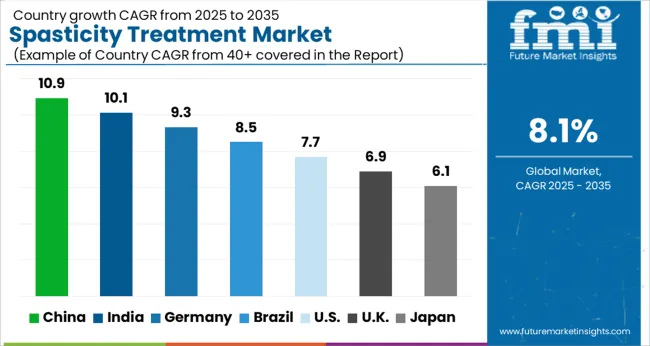
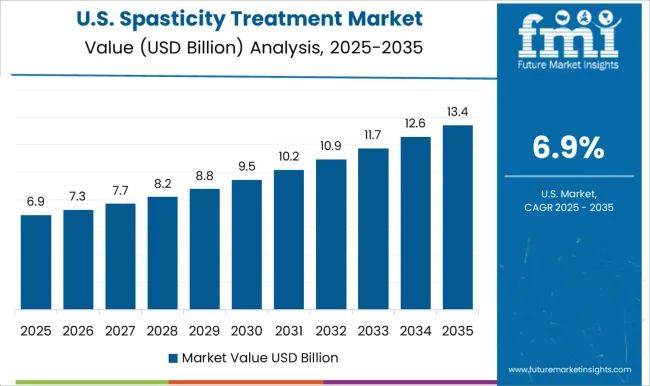
The USA market dominated the global market with value of around USD 3.63 Bilion in 2025 and is expected to register a CAGR of 8.3% during the forecast period.
The high prevalence of spasticity in the United States will accelerate the acceptance of various treatment alternatives.
Due to the high prevalence, more treatments, including over-the-counter products, will experience a high adoption rate among patients. The demand for spasticity treatment will increase due to high prevalence, which will drive the expansion of the market.
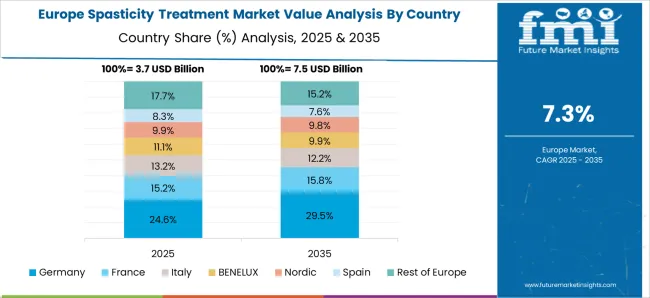
Germany dominated the European market for spasticity treatment and accounted for around 22.3% of the regional market share in 2025.
Increasing technological advancements in spasticity treatment therapies in Germany is driving the overall Europe spasticity treatment market.
Virtual reality technology can be used to provide immersive therapy experiences for patients with spasticity. These experiences can help patients to improve their motor skills and reduce spasticity through interactive and engaging activities. This therapy has been found to be effective in reducing spasticity in patients with cerebral palsy, multiple sclerosis, and other neurological conditions.
The safe and successful spasticity treatment therapies in Germany will influence other European countries to also opt for this treatment method, ultimately expanding the overall market.
China is projected to be the most attractive market in the East Asia region, and is expected to grow over a significant CAGR of 7.7% during the forecast duration.
The spasticity treatment market in China is expected to grow significantly in the coming years due to several factors.
One of the main factors driving the growth of the spasticity treatment market in China is the increasing awareness of the condition among the general public and healthcare professionals. As more people become aware of the condition, they are more likely to seek treatment, which is leading to increased demand for treatments for spasticity.
Another factor contributing to the growth of the spasticity treatment market in China is the increasing availability of advanced medical technologies and treatments. China has made significant investments in its healthcare infrastructure, and many new hospitals and clinics have been built in recent years. This has allowed for the introduction of advanced treatments such as botox injections and surgery, which were not widely available in the past.
The treatment segment utilizing drugs, physical therapy, Botulinum toxin, surgical treatment and others treatment options held the major chunk of about 68.4% in global market by the end of 2025.
With advances in medical technology, it has become easier to diagnose spasticity accurately. This has led to more people being diagnosed with the condition, which in turn has increased the demand for treatment. There is now more awareness about spasticity among healthcare providers, patients, and the general public. This has helped to reduce the stigma associated with the condition and encouraged more people to seek treatment.
There have been significant advances in the development of new treatments for spasticity, including medications, physical therapy, and surgical procedures. These treatments can help to reduce spasticity and improve overall quality of life for people with the condition.
The Cerebral Palsy segment held the major chunk of about 14.4% in global market by the end of 2025.
Increased awareness of cerebral palsy and improved diagnostic techniques have led to more accurate diagnosis and reporting of cases, contributing to the observed increase in prevalence. Certain risk factors, such as maternal infections during pregnancy, prematurity, and low birth weight, have become more common in recent years. This has contributed to the increase in the incidence of cerebral palsy and spasticity.
The hospital pharmacies segment accounted for revenue share of 38.3% in the global market at the end of 2025.
Hospital pharmacies offer convenient access to treatment options, with many providing over-the-counter and prescription medications for a range of conditions, including cerebral palsy, multiple sclerosis among others. Patients can typically purchase these treatments without an appointment, making it more convenient for them to manage their condition.
Overall, hospital pharmacies offers a convenient and accessible distribution channel for spasticity treating products, making it the largest channel for these treatments.
The hospitals segment accounted for revenue share of 37.1% in the global market at the end of 2025.
Hospitals typically have access to a wide range of specialized medical professionals, including neurologists, physiatrists, orthopedic surgeons, and physical therapists, who can collaborate to provide comprehensive spasticity treatment.
Overall, hospitals are a leading segment for spasticity treatment because they provide access to specialized medical professionals, advanced diagnostic tools, multimodal treatments, specialized equipment and facilities, and both inpatient and outpatient services.
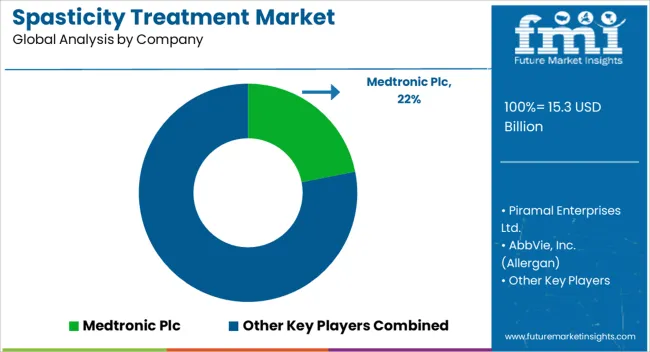
Key players in the market are focused on increase their product portfolio to strengthen their position in the spasticity treatment market, and also to expand their footprint in emerging markets. The key strategy adopted by manufacturers to gain competitive edge in the market are the pricing strategies, market strategies, technological advancements, regulatory compliance and acquisition of other companies to expand their business.
For instance:
Similarly, recent developments have been tracked by the team at Future Market Insights related to companies in the spasticity treatment market space, which are available in the full report
| Attribute | Details |
|---|---|
| Forecast Period | 2025 to 2035 |
| Historical Data Available for | 2012 to 2025 |
| Market Analysis | USD Million for Value |
| Key Regions Covered | North America; Latin America; Europe; South Asia; East Asia; Oceania; Middle East and Africa (MEA) |
| Key Countries Covered | USA, Canada, Brazil, Mexico, Argentina, Germany, United Kingdom, France, Italy, Spain, Russia, BENELUX, Nordics, India, Thailand, Indonesia, Malaysia, Philippines, Vietnam, China, Japan, South Korea, Australia, New Zealand, Türkiye, South Africa, North Africa and GCC Countries |
| Key Segments Covered | Diagnosis & Treatment Type, Indication, Distribution Channel, Service Providers, and Region |
| Key Companies Profiled | Medtronic Plc; Piramal Enterprises Ltd.; AbbVie, Inc. (Allergan); Ipsen Pharma; F. Hoffmann-La Roche Ltd; GlaxoSmithKline plc; Pfizer Inc.; Elite Pharmaceuticals Inc.; Orient Pharma; Acorda Therapeutics, Inc.; Sun Pharmaceutical Industries Ltd; Novartis AG (Alcon); Teva Pharmaceutical Industries Ltd; Zydus Cadila Healthcare Ltd.; Beximco Pharmaceuticals Ltd; Merz Pharma; Thought Technology Ltd.; UltraCare PRO; Invacare Corporation; ATI Physical Therapy; P.T. Services Rehabilitation, Inc.; Banner Health |
| Report Coverage | Market Forecast, Competition Intelligence, DROT Analysis, Market Dynamics and Challenges, Strategic Growth Initiatives |
| Customization & Pricing | Available upon Request |
The global spasticity treatment market is estimated to be valued at USD 15.3 billion in 2025.
The market size for the spasticity treatment market is projected to reach USD 33.4 billion by 2035.
The spasticity treatment market is expected to grow at a 8.1% CAGR between 2025 and 2035.
The key product types in spasticity treatment market are diagnosis, _inpatient, _outpatient, treatment type, drug, _physical therapy, _botulinum injection, _surgery treatment, _other treatment, devices, _reciprocal emg-triggered stimulation, _transcutaneous electrical nerve stimulation, _bracing and cuff, _leg lifter, _cane and crunches, _wheelchair and _others.
In terms of indication, cerebral palsy segment to command 41.8% share in the spasticity treatment market in 2025.






Full Research Suite comprises of:
Market outlook & trends analysis
Interviews & case studies
Strategic recommendations
Vendor profiles & capabilities analysis
5-year forecasts
8 regions and 60+ country-level data splits
Market segment data splits
12 months of continuous data updates
DELIVERED AS:
PDF EXCEL ONLINE
Paediatric Spasticity Treatment Market Size and Share Forecast Outlook 2025 to 2035
Treatment-Resistant Hypertension Management Market Size and Share Forecast Outlook 2025 to 2035
Treatment-Resistant Depression Treatment Market Size and Share Forecast Outlook 2025 to 2035
Treatment Pumps Market Insights Growth & Demand Forecast 2025 to 2035
Pretreatment Coatings Market Size and Share Forecast Outlook 2025 to 2035
Air Treatment Ozone Generator Market Size and Share Forecast Outlook 2025 to 2035
CNS Treatment and Therapy Market Insights - Trends & Growth Forecast 2025 to 2035
Seed Treatment Materials Market Size and Share Forecast Outlook 2025 to 2035
Acne Treatment Solutions Market Size and Share Forecast Outlook 2025 to 2035
Scar Treatment Market Overview - Growth & Demand Forecast 2025 to 2035
Soil Treatment Chemicals Market
Water Treatment Market Size and Share Forecast Outlook 2025 to 2035
Water Treatment Ozone Generator Market Size and Share Forecast Outlook 2025 to 2035
Water Treatment Equipment Market Size and Share Forecast Outlook 2025 to 2035
Burns Treatment Market Overview – Growth, Demand & Forecast 2025 to 2035
CRBSI Treatment Market Insights - Growth, Trends & Forecast 2025 to 2035
Water Treatment Polymers Market Growth & Demand 2025 to 2035
Water Treatment System Market Growth - Trends & Forecast 2025 to 2035
Algae Treatment Chemical Market Growth – Trends & Forecast 2024-2034
Water Treatment Chemical Market Growth – Trends & Forecast 2024-2034

Thank you!
You will receive an email from our Business Development Manager. Please be sure to check your SPAM/JUNK folder too.
Chat With
MaRIA